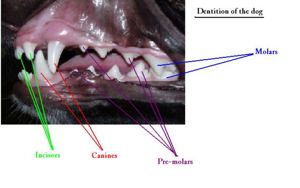Difference between revisions of "Dental Formula - Dog"
Jump to navigation
Jump to search
Fiorecastro (talk | contribs) |
|||
| (35 intermediate revisions by 5 users not shown) | |||
| Line 1: | Line 1: | ||
| − | + | ===The Dog=== | |
| − | == | ||
| − | |||
| − | + | '''Dental Formula''' | |
| + | 2 (I3/3 C1/1 P3/3) Deciduous | ||
| − | + | 2 (I3/3 C1/1 P4/4 M2/3) Permanent | |
| − | + | *Toothless at birth | |
| − | + | *Deciduous teeth complete and functional within 2 months of birth | |
| − | |||
| − | + | *Permanent teeth complete and funtional by the end of the 6th or 7th month | |
| − | |||
| − | + | '''Canines''' | |
| − | |||
| − | + | *Large, curved, laterally compressed | |
| − | |||
| − | + | *[[Root - Anatomy & Physiology|Root]] longer than [[Crown|crown]] | |
| − | + | *Single [[Root - Anatomy & Physiology|root]] | |
| + | [[Image:Dog Dentition.jpg|thumb|right|300px|Dog Dentition - Copyright Nottingham 2008]] | ||
| + | '''Molars''' | ||
| − | + | *Broader than premolars | |
| − | |||
| − | |||
| − | |||
| + | *Number of cusps similar in all breeds- usually two or three | ||
| − | + | '''Incisors''' | |
| − | | | + | |
| + | *Tricupsid in upper jaw | ||
| + | |||
| + | *Bicusped in lower jaw | ||
| + | |||
| + | *Smaller rostrally | ||
| + | |||
| + | *Single [[Root - Anatomy & Physiology|root]] | ||
| + | |||
| + | '''Premolars''' | ||
| + | |||
| + | *Irregular, closely-spaced | ||
| + | |||
| + | *More complex and larger caudally | ||
| + | |||
| + | *Discontinuous cutting edge on [[Crown|crowns]] | ||
| + | |||
| + | '''Breed Differences''' | ||
| + | |||
| + | *Eruption times differ between breeds so difficult to age dogs by teeth | ||
| + | |||
| + | *Brachiocephalic dogs do not possess all cheek teeth, have fused [[Root - Anatomy & Physiology|roots]] and have carnasial teeth (upper P4 and lower M1) | ||
| − | |||
| − | |||
| − | |||
[[Category:Teeth - Anatomy & Physiology]] | [[Category:Teeth - Anatomy & Physiology]] | ||
[[Category:Dog - Alimentary System]] | [[Category:Dog - Alimentary System]] | ||
| − | |||
| − | |||
| − | |||
Revision as of 14:24, 3 September 2010
The Dog
Dental Formula
2 (I3/3 C1/1 P3/3) Deciduous
2 (I3/3 C1/1 P4/4 M2/3) Permanent
- Toothless at birth
- Deciduous teeth complete and functional within 2 months of birth
- Permanent teeth complete and funtional by the end of the 6th or 7th month
Canines
- Large, curved, laterally compressed
- Single root
Molars
- Broader than premolars
- Number of cusps similar in all breeds- usually two or three
Incisors
- Tricupsid in upper jaw
- Bicusped in lower jaw
- Smaller rostrally
- Single root
Premolars
- Irregular, closely-spaced
- More complex and larger caudally
- Discontinuous cutting edge on crowns
Breed Differences
- Eruption times differ between breeds so difficult to age dogs by teeth
- Brachiocephalic dogs do not possess all cheek teeth, have fused roots and have carnasial teeth (upper P4 and lower M1)
